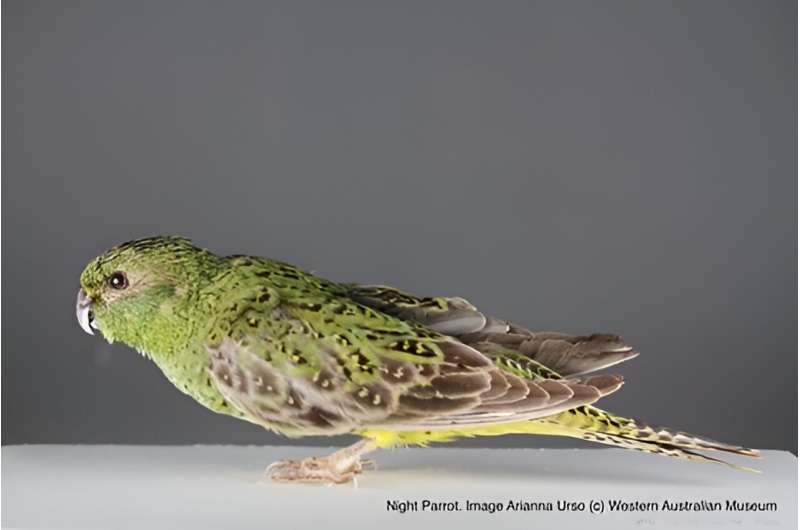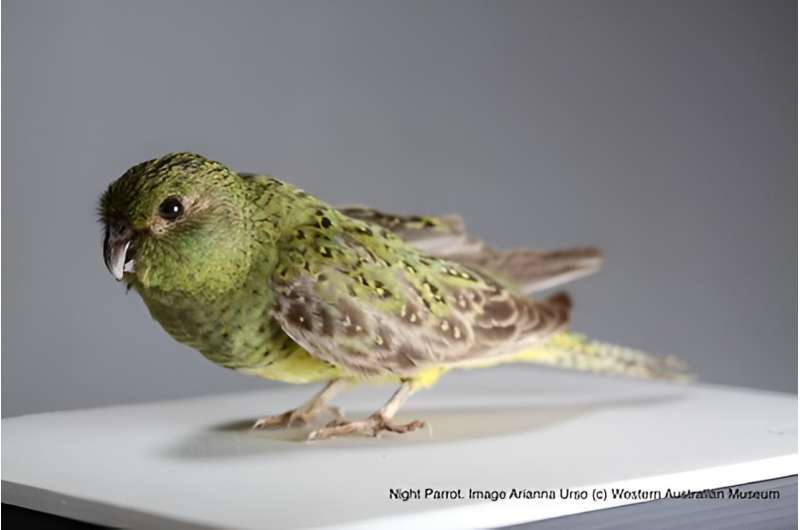This article has been reviewed according to Science X's editorial process and policies. Editors have highlighted the following attributes while ensuring the content's credibility:
fact-checked
trusted source
proofread
Secrets of night parrot unlocked after first genome sequenced

Researchers at CSIRO, Australia's national science agency, have sequenced the first genome of the night parrot, one of the world's rarest and most elusive birds. The development will answer questions about population genetics and biology that could boost conservation hopes for the recently rediscovered species.
"The genome will enable us to explore the genetic basis of why the night parrot is nocturnal, a very unusual feature in parrots. We'll investigate faculties like navigation, smell, beak shape and its less-than-optimal night vision," said Dr. Leo Joseph, Director of CSIRO's Australian National Wildlife Collection.
"Researchers will also be able to run statistical analyses on the genome of this individual to estimate past population sizes of night parrot populations in Australia. Now, we have the capability to compare this annotated genome with other closely related parrots, shedding light on the reasons behind its scarcity and limited distribution compared to many of its relatives."
CSIRO researchers sequenced the night parrot genome—its genetic blueprint—using tissue obtained from Dr. Kenny Travouillon, Acting Curator of Ornithology at the Western Australian Museum, after Traditional Owners in the Pilbara found the deceased specimen and delivered it to the Museum Boola Bardip.
The specimen, which is the best-preserved on display in the world, is now open to public viewing at the WA Museum Boola Bardip.
Dr. Gunjun Pandey, who led the night parrot genomics project, said access to high-throughput DNA sequencing technology under CSIRO's Applied Genomics Initiative is accelerating genomics research in Australia.

"We can now generate very high-quality genomes from really tiny tissue samples—even as small as an ant's head or a single mosquito," Dr. Pandey said. "This level of quality and detail just wasn't possible even five years ago. The genetic data can be used to ensure conservation programs maximize diversity, so the species is resilient and has the best chance of long-term survival."
Once more widespread in arid Australia, the night parrot declined due to environmental changes such as predation by cats and foxes. It is now known only from localized parts of southwest Queensland and Western Australia.
"A couple of dozen scientific specimens were collected during the nineteenth century and one in 1912. Then a specimen was found in 1990 in southwest Queensland," Dr. Joseph said. "Live birds were reported from the same area in 2013, and a live parrot was finally caught and tagged in 2015."
While the night parrot genome is an exciting scientific resource to understand more about this bird, protecting the species from cats, foxes, fire and habitat loss is also crucial for their conservation.
"The night parrot genome will open up numerous opportunities for further research to help conserve this species," Dr. Pandey said. "This will empower scientists to develop a plan for saving the night parrot, which is the ultimate goal of sequencing the genome and making it publicly available."
More information: The annotated genome is now available online as part of the NCBI Reference Sequence (RefSeq) Database through NCBI Datasets.
Provided by CSIRO



















